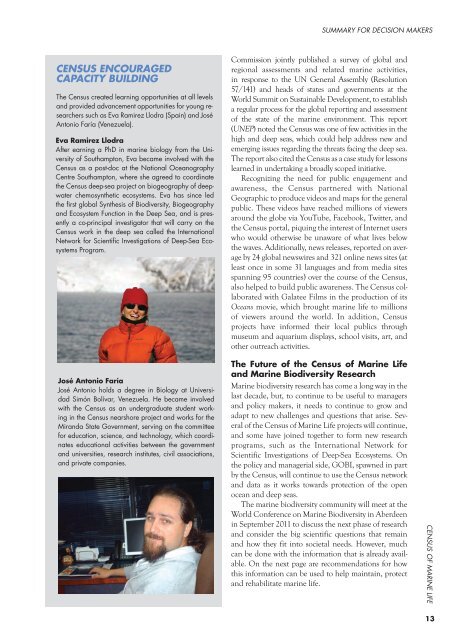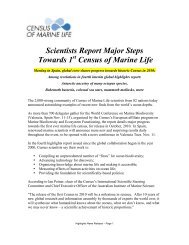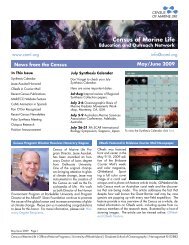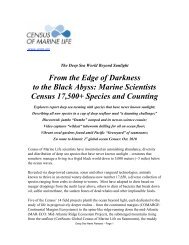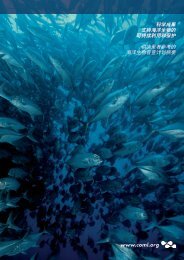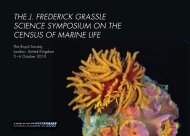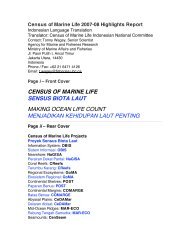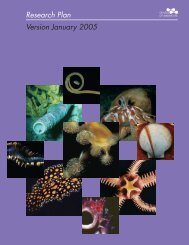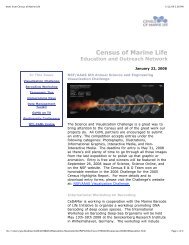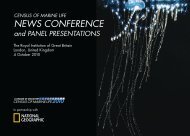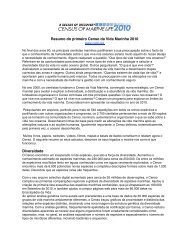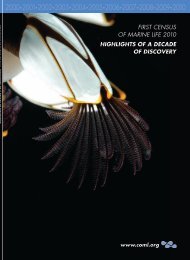policy report - Census of Marine Life
policy report - Census of Marine Life
policy report - Census of Marine Life
- No tags were found...
You also want an ePaper? Increase the reach of your titles
YUMPU automatically turns print PDFs into web optimized ePapers that Google loves.
SUMMARY FOR DECISION MAKERSCENSUS ENCOURAGEDCAPACITY BUILDINGThe <strong>Census</strong> created learning opportunities at all levelsand provided advancement opportunities for young researcherssuch as Eva Ramirez Llodra (Spain) and JoséAntonio Faría (Venezuela).Eva Ramirez LlodraAfter earning a PhD in marine biology from the University<strong>of</strong> Southampton, Eva became involved with the<strong>Census</strong> as a post-doc at the National OceanographyCentre Southampton, where she agreed to coordinatethe <strong>Census</strong> deep-sea project on biogeography <strong>of</strong> deepwaterchemosynthetic ecosystems. Eva has since ledthe first global Synthesis <strong>of</strong> Biodiversity, Biogeographyand Ecosystem Function in the Deep Sea, and is presentlya co-principal investigator that will carry on the<strong>Census</strong> work in the deep sea called the InternationalNetwork for Scientific Investigations <strong>of</strong> Deep-Sea EcosystemsProgram.Commission jointly published a survey <strong>of</strong> global andregional assessments and related marine activities,in response to the UN General Assembly (Resolution57/141) and heads <strong>of</strong> states and governments at theWorld Summit on Sustainable Development, to establisha regular process for the global <strong>report</strong>ing and assessment<strong>of</strong> the state <strong>of</strong> the marine environment. This <strong>report</strong>(UNEP) noted the <strong>Census</strong> was one <strong>of</strong> few activities in thehigh and deep seas, which could help address new andemerging issues regarding the threats facing the deep sea.The <strong>report</strong> also cited the <strong>Census</strong> as a case study for lessonslearned in undertaking a broadly scoped initiative.Recognizing the need for public engagement andawareness, the <strong>Census</strong> partnered with NationalGeographic to produce videos and maps for the generalpublic. These videos have reached millions <strong>of</strong> viewersaround the globe via YouTube, Facebook, Twitter, andthe <strong>Census</strong> portal, piquing the interest <strong>of</strong> Internet userswho would otherwise be unaware <strong>of</strong> what lives belowthe waves. Additionally, news releases, <strong>report</strong>ed on averageby 24 global newswires and 321 online news sites (atleast once in some 31 languages and from media sitesspanning 95 countries) over the course <strong>of</strong> the <strong>Census</strong>,also helped to build public awareness. The <strong>Census</strong> collaboratedwith Galatee Films in the production <strong>of</strong> itsOceans movie, which brought marine life to millions<strong>of</strong> viewers around the world. In addition, <strong>Census</strong>projects have informed their local publics throughmuseum and aquarium displays, school visits, art, andother outreach activities.José Antonio FaríaJosé Antonio holds a degree in Biology at UniversidadSimón Bolívar, Venezuela. He became involvedwith the <strong>Census</strong> as an undergraduate student workingin the <strong>Census</strong> nearshore project and works for theMiranda State Government, serving on the committeefor education, science, and technology, which coordinateseducational activities between the governmentand universities, research institutes, civil associations,and private companies.The Future <strong>of</strong> the <strong>Census</strong> <strong>of</strong> <strong>Marine</strong> <strong>Life</strong>and <strong>Marine</strong> Biodiversity Research<strong>Marine</strong> biodiversity research has come a long way in thelast decade, but, to continue to be useful to managersand <strong>policy</strong> makers, it needs to continue to grow andadapt to new challenges and questions that arise. Several<strong>of</strong> the <strong>Census</strong> <strong>of</strong> <strong>Marine</strong> <strong>Life</strong> projects will continue,and some have joined together to form new researchprograms, such as the International Network forScientific Investigations <strong>of</strong> Deep-Sea Ecosystems. Onthe <strong>policy</strong> and managerial side, GOBI, spawned in partby the <strong>Census</strong>, will continue to use the <strong>Census</strong> networkand data as it works towards protection <strong>of</strong> the openocean and deep seas.The marine biodiversity community will meet at theWorld Conference on <strong>Marine</strong> Biodiversity in Aberdeenin September 2011 to discuss the next phase <strong>of</strong> researchand consider the big scientific questions that remainand how they fit into societal needs. However, muchcan be done with the information that is already available.On the next page are recommendations for howthis information can be used to help maintain, protectand rehabilitate marine life.CENSUS OF MARINE LIFE13


